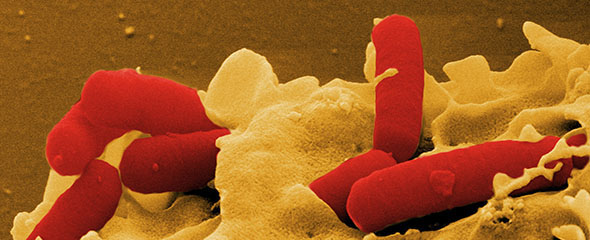Listeria are rod-shaped bacteria of the genus Listeria. They live and multiply on improperly processed foods, especially meat, fish and dairy products. If they are ingested in increased quantities, the pathogens can make us ill.
Biomarkers and antibodies for Listeria bacteria
The team from the Institute for Biochemistry, Biotechnology and Bioinformatics at TU Braunschweig has found a new biomarker on the bacteria, the enzyme pyruvate dehydrogenase complex. Such biomarkers make it possible to accurately detect the pathogens in food samples. For such detection, the researchers have also generated new antibodies against the protein. For this purpose, they used the so-called phage display. This is a method from biotechnology: biological structures, such as proteins or antigens, are presented on the surface of a phage – a virus that infects bacteria. In this way, suitable binding partners can be found.
Three phage display technologies at work
The Braunschweig scientists successively used three variants of phage display technologies to identify the biomarker, produce the antibodies against Listeria and precisely analyse their interaction with the biomarker. Using the antibody phage display, they first selected antibodies against Listeria in the test tube. In the process, they found antibodies that identified the bacteria very specifically. To find the biomarker, they used the so-called ORFeome phage display: This involved presenting parts of Listeria proteins on the phage surface and checking which of the proteins bind to the antibodies. Finally, the binding site, the epitope, between the biomarker and the antibody was precisely determined using the single gene phage display.
Use in diagnostics
Listeria can be detected using various diagnostic methods, e.g. the polymerase chain reaction (PCR) or the enzyme-linked immunosorbent assay (ELISA). The new biomarkers and antibodies discovered by the scientists offer opportunities to improve the detection of Listeria, especially in countries where diagnostics are not yet as advanced as in Germany. “Our research should help to simplify and improve the detection of pathogenic bacteria in food. This is important for us, but also worldwide, because many foods are also produced for export,” says Dr. Gustavo Moreira from the Institute of Biochemistry, Biotechnology and Bioinformatics (IB³) at TU Braunschweig.
Cooperation with national and international partners
Professor Michael Hust, also from IB³, added: “This project shows how well we work together in the Forschungsregion Braunschweig and also the international importance of our research”. Together with the Leibniz Institute DSMZ-German Collection of Microorganisms and Cell Cultures, the binding of antibodies to numerous bacterial strains was investigated. The Helmholtz Centre for Infection Research (HZI) validated the results by testing whether the antibodies bind to the pyruvate dehydrogenase complex. The Brazilian partners are involved in the further development of a rapid test for food.
To the press release of the TU Braunschweig
Original publication:
Moreira, G.M.S.G., Köllner, S.M.S., Helmsing, S. et al. Pyruvate dehydrogenase complex—enzyme 2, a new target for Listeria spp. detection identified using combined phage display technologies. Sci Rep 10, 15267 (2020). https://doi.org/10.1038/s41598-020-72159-4

